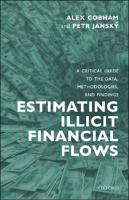Estimating Illicit Financial Flows
A Critical Guide to the Data, Methodologies, and Findings
| dc.contributor.author | Cobham, Alex | |
| dc.contributor.author | Janský, Petr | |
| dc.date.accessioned | 2020-04-29T08:40:07Z | |
| dc.date.available | 2020-04-29T08:40:07Z | |
| dc.date.issued | 2020 | |
| dc.identifier | OCN: 1142505251 | |
| dc.identifier.uri | http://library.oapen.org/handle/20.500.12657/37433 | |
| dc.description.abstract | Illicit financial flows constitute a global phenomenon of massive but uncertain scale, which erodes government revenues and drives corruption in countries rich and poor. In 2015, the countries of the world committed to a target to reduce illicit flows, as part of the UN Sustainable Development Goals. But five years later, there is still no agreement on how that target should be monitored—to say nothing of how it will be achieved. The term ‘illicit financial flows’ covers a range of corrupt practices, aimed at obtaining immunity or impunity from criminal law, from market regulation and from taxation. Illicit flows occur through many different channels, whether they involve laundering the proceeds of crime, for example, or shifting the profits of multinational companies. There are two consistent features. First, illicit flows are deliberately hidden. These cross-border movements of assets and income streams depend on a set of common tools including opaque company accounts, legal vehicles for anonymous ownership, and the secrecy jurisdictions that provide these services. Second, the overall effect of illicit flows is to reduce the revenue available to states, and to weaken the quality of governance—so there is less money to support human development, and it is less likely to be spent well. In this book, two of the economists most closely involved in the process to develop UN indicators of illicit financial flows offer a critical survey of the existing data and methodologies, identifying the most promising avenues for future improvement and setting out their own proposals. | en_US |
| dc.language | English | en_US |
| dc.subject.classification | thema EDItEUR::K Economics, Finance, Business and Management::KC Economics | en_US |
| dc.subject.classification | thema EDItEUR::K Economics, Finance, Business and Management::KC Economics::KCM Development economics and emerging economies | en_US |
| dc.subject.classification | thema EDItEUR::K Economics, Finance, Business and Management::KC Economics::KCF Labour / income economics | en_US |
| dc.subject.classification | thema EDItEUR::K Economics, Finance, Business and Management::KC Economics::KCV Economics of specific sectors::KCVD Agricultural and rural economics | en_US |
| dc.subject.other | Illicit financial flows | en_US |
| dc.subject.other | SDGs | en_US |
| dc.subject.other | tax evasion | en_US |
| dc.subject.other | tax avoidance | en_US |
| dc.subject.other | offshore | en_US |
| dc.subject.other | trade misinvoicing | en_US |
| dc.subject.other | profit shifting | en_US |
| dc.subject.other | estimates | en_US |
| dc.subject.other | methodologies | en_US |
| dc.subject.other | data | en_US |
| dc.title | Estimating Illicit Financial Flows | en_US |
| dc.title.alternative | A Critical Guide to the Data, Methodologies, and Findings | en_US |
| dc.type | book | |
| oapen.identifier.doi | 10.1093/oso/9780198854418.001.0001 | en_US |
| oapen.relation.isPublishedBy | b9501915-cdee-4f2a-8030-9c0b187854b2 | en_US |
| oapen.pages | 224 | en_US |
| oapen.place.publication | Oxford | en_US |
| oapen.remark.public | Funder name: Tax Justice Network |

